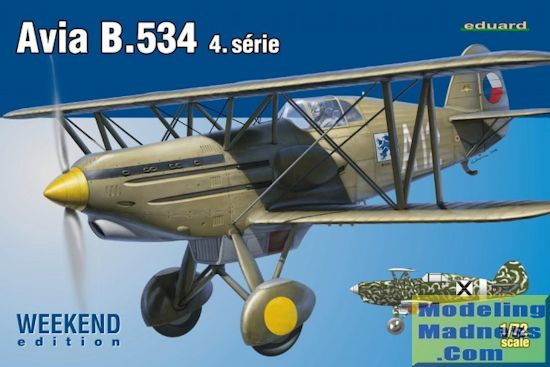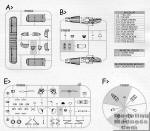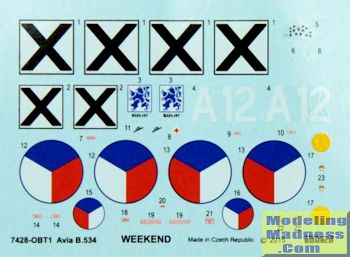
Eduard 1/72 Avia B.534 4.serie
| KIT #: | 7428 |
| PRICE: | $16.95 MSRP |
| DECALS: | Two Options |
| REVIEWER: | Scott Van Aken |
| NOTES: | Weekend Edition |

| HISTORY |
The B-534 was designed as a single-engine biplane fighter with a license-built Hispano-Suiza inline powerplant, and fixed landing gear. Four 7.92 mm (0.312 in) machine guns were located in the sides of the fuselage, firing through the propeller. The air forces of the 1930s were reluctant to abandon the maneuverability and climb rates of biplanes for the speed of monoplanes, even in the face of new and better technology. The success of the Soviet pilots with biplanes may have contributed to this reluctance; they were known to strip their aircraft of sliding canopies, preferring to have the wind in their faces. Aircraft with two fabric-covered wings and fixed landing gear were also less expensive to manufacture.
The first B-534 prototype flew in late May 1933. More work followed and the first order for the Czechoslovakian Air Force was placed in mid-1934. At that time, the B-534 was well ahead of its contemporaries. The United Kingdom was still dependent on Hawker Furies, with the first Gloster Gladiators being produced at this time. The Soviet Union was placing its hope on its Polikarpov aircraft designs. The United States was still using descendants of the Curtiss Hawk series, with the Seversky P-35 and Curtiss P-36 just about to fly prototypes. First deliveries of the B-534 to the Czechoslovakian air force began in late 1935, and 445 or so had been completed by 1938.
The abrupt partition of Czechoslovakia in 1939 prevented the use of the B-534 in combat by the nation that had produced it. By then, high performance monoplanes such as the German Messerschmitt Bf 109, Hawker Hurricane and Supermarine Spitfire were raising the bar of fighter/interceptor standards. Four sub-types were produced during the B-534's production run, all with mostly minor improvements.
One major variation was introduced in this production run. The B-534 was designed to carry one 20 mm (0.79 in) cannon firing through the nose and only two 7.92 mm (0.312 in) machine guns to the sides. Developmental problems prevented the cannon from ever being used and, desperate to get more aircraft in the air, Avia decided to use a third machine gun in the nose only weeks before the German annexation of Czechoslovakia. Only three machines with this configuration were completed for the Czech air force, and the remaining production block was finished for the Germans.
The aircraft was built in four different series, each slightly different from the previous. This kit is of the last series built, which is distinguished by a fully enclosed canopy.
| THE KIT |
 I
have always liked Eduard's Weekend Edition series and frequently will forego
purchasing one of their kits until such a time as they offer this version. I
have found that the addition of a lot of resin and photo etch will significantly
increase the amount of time it takes for me to finish a kit. While all the
additional bits are really a good deal for those who want all that stuff, I'd
rather have a simpler kit.
I
have always liked Eduard's Weekend Edition series and frequently will forego
purchasing one of their kits until such a time as they offer this version. I
have found that the addition of a lot of resin and photo etch will significantly
increase the amount of time it takes for me to finish a kit. While all the
additional bits are really a good deal for those who want all that stuff, I'd
rather have a simpler kit.
Now this has brought forth some issues with the W.E. kits. For instance, often a specific detail will only be provided in p.e. and so when the W.E. kit is produced, you are left with either an inability to properly depict what is boxed or a flat piece of plastic that should have some sort of detail in that area. This can be infuriating, but it seems that, to some extent, Eduard has come to realized this situation and at least on this kit, has provided a partial solution of sorts. You see, the carb intake and the aft radiator detail in the Profipak kit is a photo etch piece. So to take care of that issue, Eduard has provided a decal. This is all well and good, but one has to be very careful when getting ready to paint to ensure that these areas are properly covered up and not with tape or that will simply pull off the decal. Ideally there would have been a plastic part provided in the standard boxing with the p.e. being an option.
As you'd expect, the plastic bits are identical in both kits and there are pieces that you will not use that are designed for other variants. There is nicely done inner cockpit sidewall detail on both sides that includes framework, but minus the p.e. levers and such. A decal is provided for the instrument panel, which is fine with most, the seat has no harness and there are only little wedges on the floor where I assume one would normally attach the p.e. rudder pedals.
Single piece tail planes, elevators and rudder are included with the kit, though it appears they are to be modeled in the neutral position. Options with the kit are limited to a tail wheel or skid, spatted or open main wheels, and an open or single piece cockpit canopy. In both canopy options, the rear quarter windows are molded into a section of upper fuselage. The metal prop is the one to use with this airplane.
 Eduard's
instructions are excellent and provide Gunze paint references. There are two
markings options, which is a bit different from the usual W.E.'s single
offering. The one with the tail skid and spats is the box art plane in Khaki
Green over Silver paint from early 1938. The other is one without spats and with
a tail wheel that was issued to the Bulgarian Air Force and on hand in November
1944, which is actually after they turned on the Germans, though I think they
kept that insignia until the end of the war. A full color markings and stencil
guide is provided as well as a full rigging diagram. There is a small addendum
sheet not shown that includes a couple of misprinted decals and the radiator
decals.
Eduard's
instructions are excellent and provide Gunze paint references. There are two
markings options, which is a bit different from the usual W.E.'s single
offering. The one with the tail skid and spats is the box art plane in Khaki
Green over Silver paint from early 1938. The other is one without spats and with
a tail wheel that was issued to the Bulgarian Air Force and on hand in November
1944, which is actually after they turned on the Germans, though I think they
kept that insignia until the end of the war. A full color markings and stencil
guide is provided as well as a full rigging diagram. There is a small addendum
sheet not shown that includes a couple of misprinted decals and the radiator
decals.
| CONCLUSIONS |
In all, a very nice kit of an important aircraft for that part of the war and one that got the last biplane air to air victory ever. It is not a difficult build aside from rigging and provides a lot more in the way of detail when compared to the previous kit in this scale, which was the 40 year old KP kit.
| REFERENCES |
http://en.wikipedia.org/wiki/Avia_B.534
April 2015
Thanks to me for picking this one up for you.
If you would like your product reviewed fairly and fairly quickly, please contact the editor or see other details in the Note to Contributors.